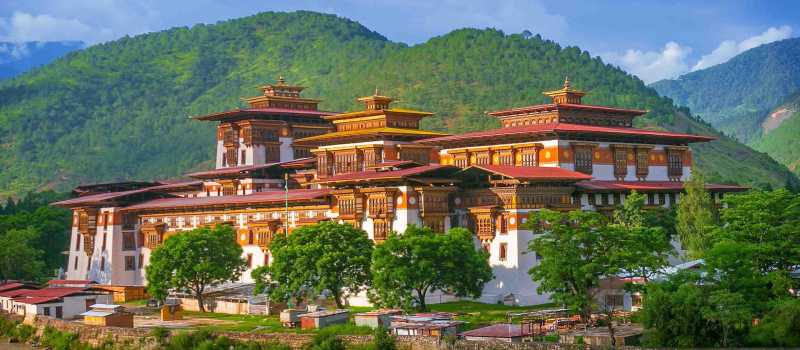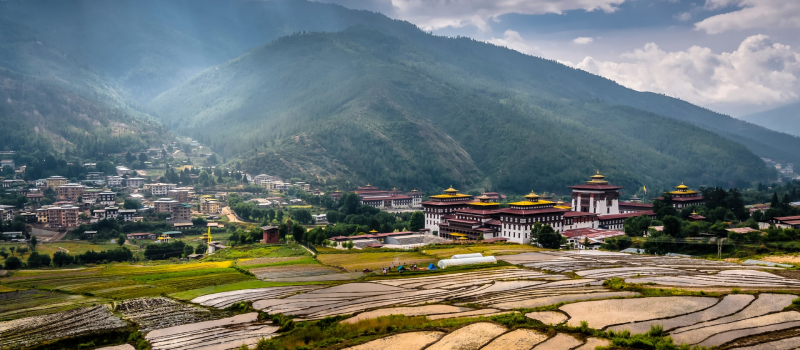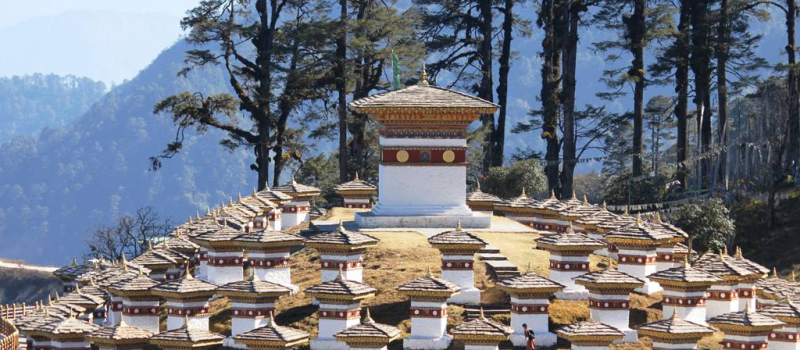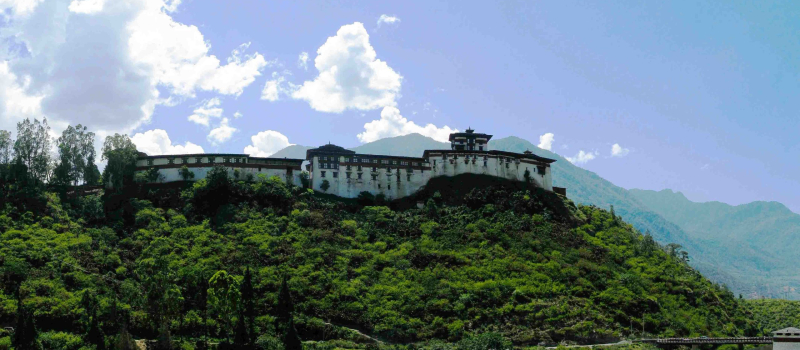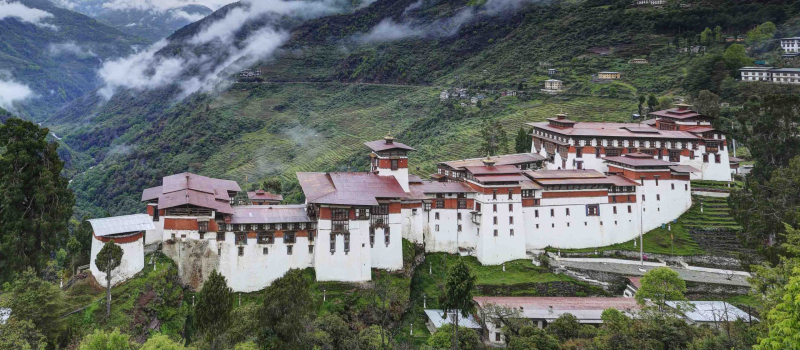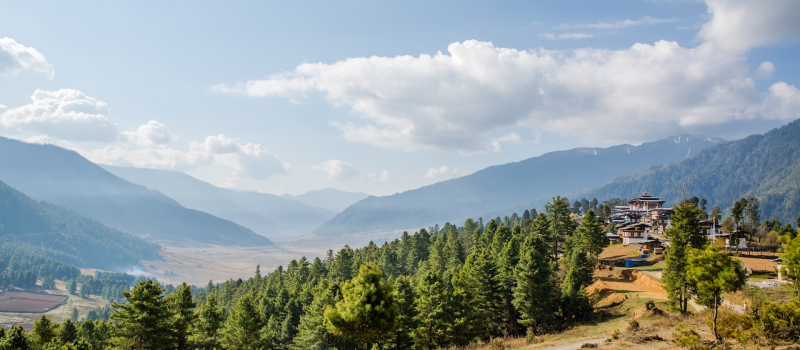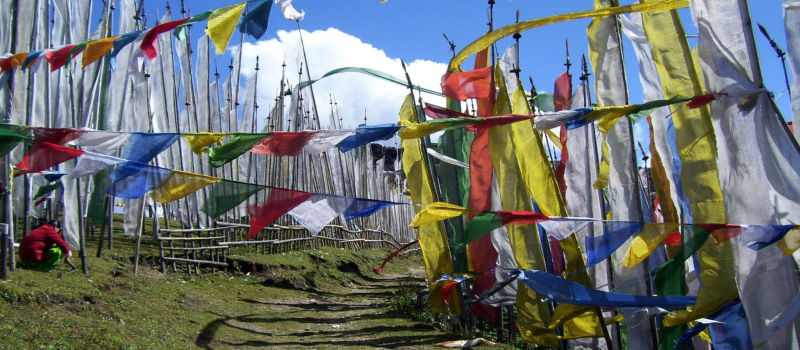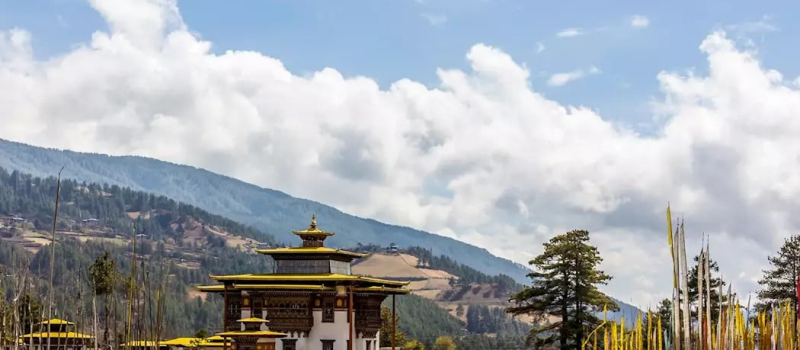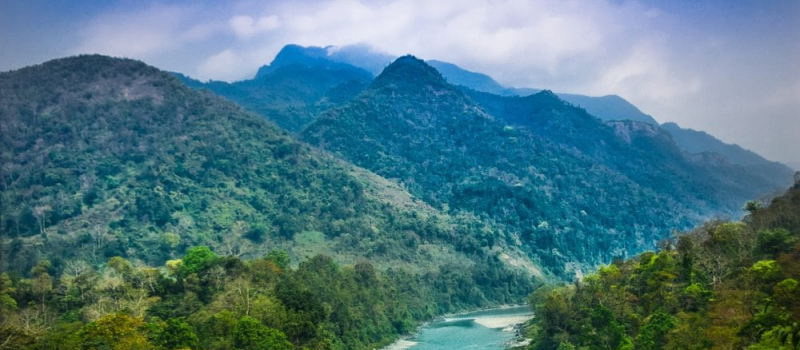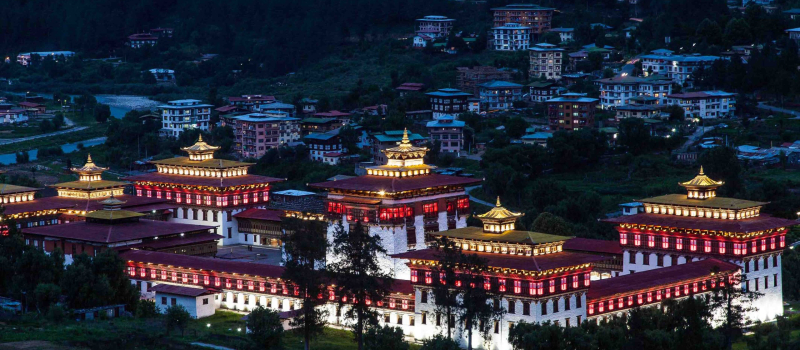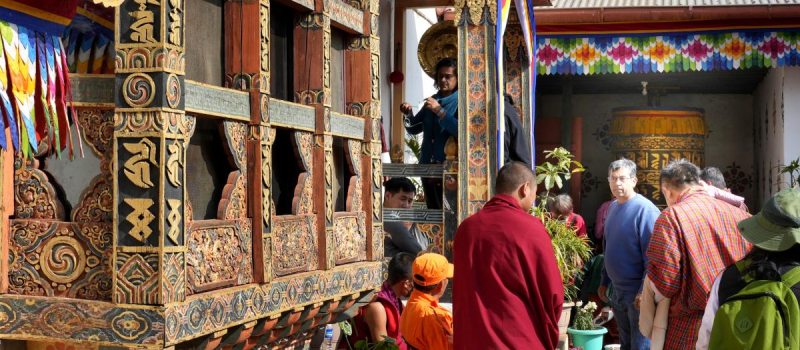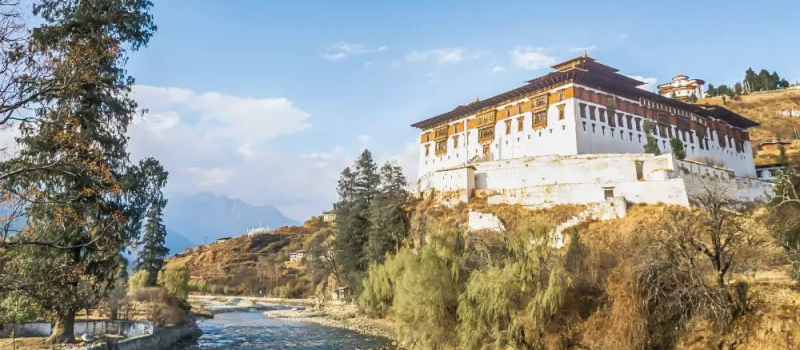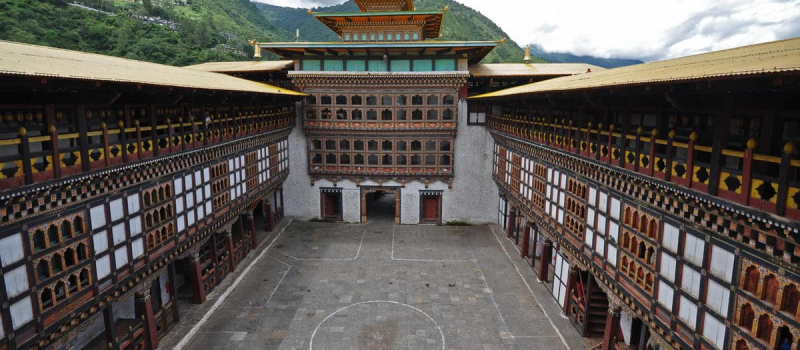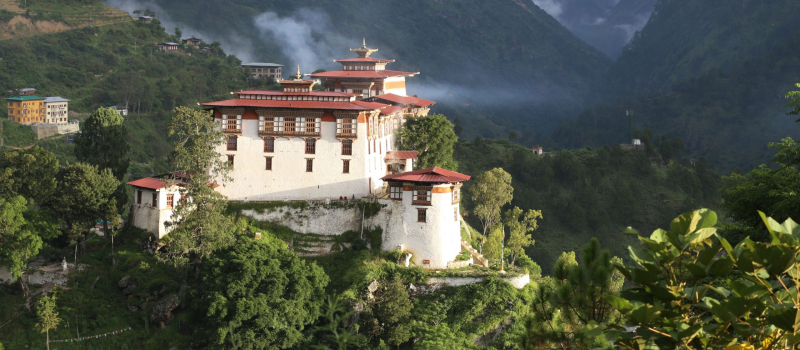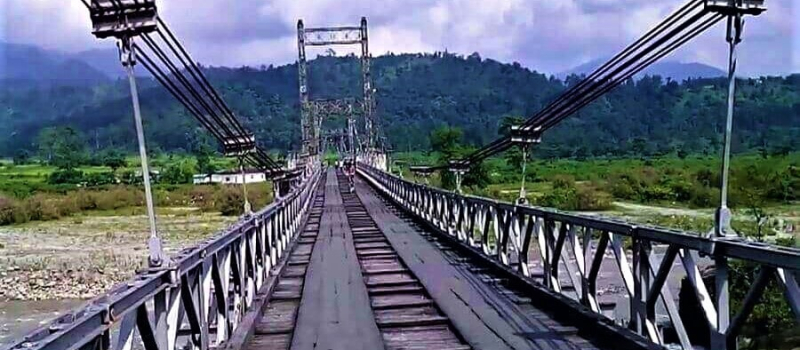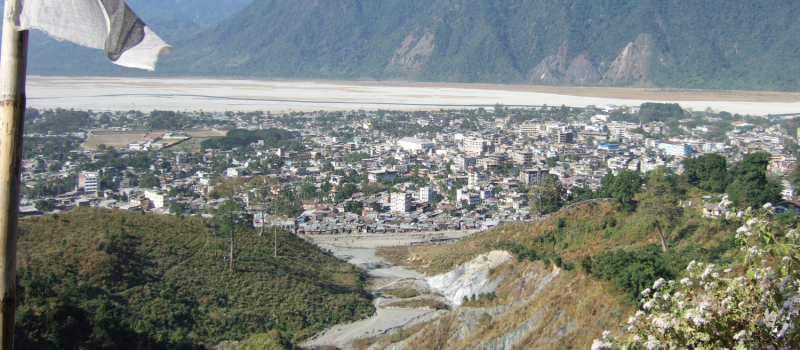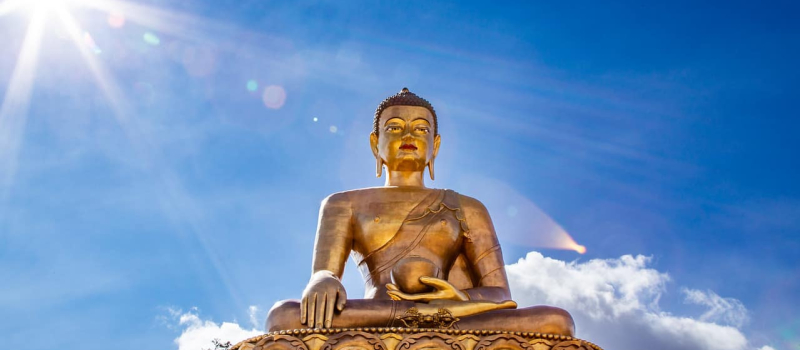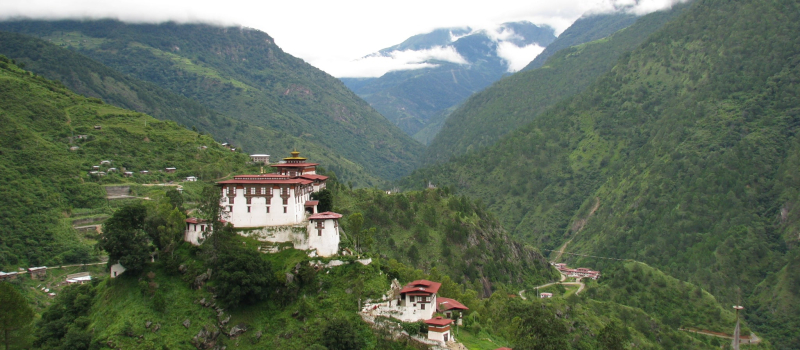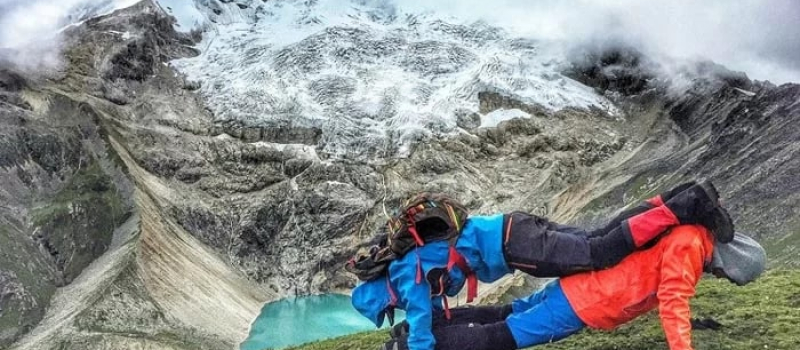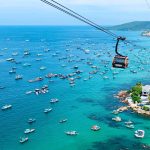20 Places to Visit in Bhutan for Extraordinary Experience
Bhutan, often called the “Land of the Thunder Dragon,” is a captivating destination with several beautiful places to visit. With its rich cultural heritage and breathtaking landscapes, Bhutan offers an array of tourist places that enchant you. From majestic monasteries to stunning valleys, Bhutan Tour Packages has something for every traveller.
Explore the iconic Tiger’s Nest Monastery, immerse yourself in the serene beauty of Punakha Dzong, and witness the vibrant markets of Thimphu. Discover Phobjikha and Haa Valley’s natural wonders, and visit the historical Trongsa Dzong. Bhutan’s famous places showcase its unique charm and provide unforgettable experiences for those seeking the best places to visit in Bhutan.
1. Paro Taktsang (Tiger’s Nest)
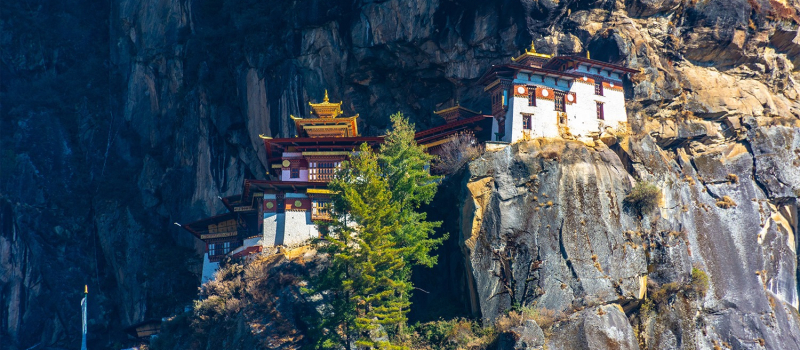
Paro Valley in Bhutan lies the iconic Paro Taktsang, Tiger’s Nest. This sacred Buddhist site is not only a testament to architectural marvel but also holds great spiritual significance.
To reach Tiger’s Nest, visitors have to cross a challenging but rewarding hike through scenic trails and lush forests. As they walk, breathtaking valley vistas unfold, adding to the sense of wonder and anticipation. Crossing a suspension bridge and ascending stone steps, travellers arrive at the monastery on the edge of the dramatic cliffs.
The sound of chanting monks and the aroma of incense fill the air, immersing visitors in a truly mystical experience. You can witness the intricate murals, prayer wheels, and sacred aura.
Standing on the terrace, overlooking the valley below, one can’t help but be awe-struck by the sheer magnificence of the surroundings. Paro Taktsang is a testament to faith and perseverance. It offers not only a glimpse into Bhutan’s religious heritage but also a chance to connect with the divine amidst the breathtaking natural beauty of Bhutan’s tourist places.
Suggested Stay Duration: 5-6 hours
2. Punakha Dzong
Chhu (Male River) and Mo Chhu (Female River) are located in the Punakha Valley, considered to be one of the most famous places in Bhutan.
Constructed in the 17th century, Punakha Dzong served as the seat of government until the capital was moved to Thimphu. The dzong’s whitewashed walls, towering golden roof, and intricately carved wooden beams exude a sense of grandeur.
Punakha Dzong also holds historical significance as the site of royal weddings and the coronation of Bhutan’s kings. The annual Punakha Tshechu, a vibrant festival featuring masked dances and religious rituals, is celebrated within the dzong’s courtyard.
Surrounded by lush greenery and the tranquil flow of rivers, Punakha Dzong radiates a sense of serenity and spiritual energy. It stands as a living testament to Bhutan and is known as one of the best places to visit in Bhutan.
Suggested Stay Duration: 1-2 hours
3. Thimphu
The picturesque valley of the Wang Chuu River, Thimphu, Bhutan Tourist place, blends traditional charm and modern development. With its stunning natural surroundings and a touch of urban vibrancy, Thimphu offers a unique glimpse into Bhutanese culture and lifestyle.
Thimphu is one of the best places to visit in Bhutan. You’ll encounter a mix of ancient traditions and contemporary influences. The city’s streets are adorned with colourful prayer flags fluttering in the breeze, and traditional architecture beautifully blends with modern structures. Thimphu, a tourist place in Bhutan, offers a range of experiences, from bustling markets where locals trade fresh produce and handicrafts to serene monasteries.
Not only cultural richness, but Thimphu boasts an emerging art and culinary scene, with contemporary art galleries, trendy cafes, and restaurants offering a fusion of Bhutanese and international flavours. Thimphu is not just a city; it’s a vibrant hub where tradition and modernity coexist harmoniously.
Suggested Stay Duration: 3-4 Hours
4. Dochula Pass
Dochula Pass- A tourist place in Bhutan, is Located at an altitude of 3,100 meters above sea level. It is known for its stunning 360-degree vistas of snow-capped peaks, including the mighty Gangkhar Puensum, the highest unclimbed mountain in the world Situated on the road between Thimphu and Punakha, this scenic pass is one of Bhutan’s famous places for travellers.
On clear days, visitors are treated to a mesmerising spectacle of the Himalayan range stretching as far as the eye can see.
The pass is adorned with 108 stupas known as the “Druk Wangyal Chortens,” built by the Queen Mother to commemorate Bhutanese soldiers who lost their lives in a military conflict. The colourful prayer flags fluttering in the wind add to the spiritual ambience of the place.
Aside from its scenic beauty, Dochula Pass offers a tranquil and refreshing respite from the lowland heat. The cool mountain air, the serene environment, and the stunning vistas make it a perfect spot for meditation, reflection, or simply enjoying the awe-inspiring natural surroundings.
Suggested Stay Duration: 3-4 Hours
5. Wangdue Phodrang
Wangdue Phodrang is a fantastic place to visit in Bhutan’s district, known for its rich cultural heritage and stunning natural beauty. It is located on the banks of the Punatsang Chhu River, a quaint town that offers a captivating blend of historical sites and idyllic landscapes.
The centrepiece of Wangdue Phodrang is the Wangdue Phodrang Dzong, an impressive fortress that overlooks the town. With its towering walls and intricate architecture, this majestic structure is a testament to Bhutanese craftsmanship and an important administrative and religious centre.
Wangdue Phodrang is also famous for its annual Tshechu festival, a vibrant celebration of Bhutanese culture that showcases colourful masked dances and religious rituals. During this time, locals and visitors come together to honour their spiritual beliefs and witness the lively festivities. Surrounded by rolling hills, terraced fields, and pristine forests, Wangdue Phodrang offers a serene and picturesque setting. Visitors can explore nearby villages, hike through scenic trails, or simply immerse themselves in the tranquil ambience of the region.
Suggested Stay Duration: 1 Day
6. Trongsa Dzong
Perched on a hilltop overlooking the Mangde River, Trongsa Dzong is a magnificent place to Visit in Bhutan. Trongsa Dzong’s impressive white walls, red roofs, and intricate woodwork make it a visual masterpiece. As one of the largest dzongs in Bhutan, it holds multiple courtyards, temples, and administrative buildings within its complex.
The dzong’s strategic location on the ancient trade route between eastern and western Bhutan was vital in controlling and governing the region. It has served as the ancestral home of the royal family and holds great historical significance as the birthplace of the first king of Bhutan.
Trongsa Dzong provides a captivating insight into Bhutan Tourist Places’ rich past. Its architectural splendour, cultural significance, and breathtaking views of the surrounding valley create an unforgettable experience. Exploring its corridors, witnessing religious ceremonies, and soaking in the aura of this majestic fortress is a journey into the heart of Bhutanese heritage and tradition.
Suggested Stay Duration: 2-3 Hours
7. Gangtey Valley
Gangtey Valley, known as Phobjikha Valley, is Bhutan’s famous place.
The valley is renowned for its unique and harmonious blend of stunning landscapes and cultural heritage. It is a designated conservation area home to the endangered black-necked cranes, which migrate from Tibet during the winter months. Seeing these graceful birds in their natural habitat is a truly remarkable experience.
Gangtey Valley also boasts the magnificent Gangtey Monastery, commonly known as Gangtey Gonpa, which is one of the spiritual places to see in Bhutan. This 17th-century monastery is an important spiritual centre for the local community and offers a glimpse into Bhutan’s rich Buddhist heritage.
Visitors to Gangtey Valley can enjoy peaceful nature walks, explore charming traditional villages, and immerse themselves in the tranquillity of the surroundings. The valley’s untouched beauty and cultural significance make it a must-visit destination for those seeking a unique and enriching experience in Bhutan.
Suggested Stay Duration: 1 Day
8. Chele La Pass
Chele La Pass is a breathtaking mountain pass to visit in Bhutan, connecting the districts of Paro and Haa. Situated at an elevation of approximately 3,988 meters (13,084 feet), it is considered one of the highest motorable passes in the country.
Bhutan’s Tourist place Chele La Pass is a popular destination among nature enthusiasts and adventure seekers. The journey to the pass takes travellers through winding roads surrounded by dense forests, blooming rhododendron trees, and picturesque landscapes.
The snow-capped peaks, deep valleys, and pristine alpine meadows paint a magnificent picture on a clear day.
Chele La Pass is also an excellent spot for hiking and trekking enthusiasts. Various trails lead to nearby monasteries and villages, allowing visitors to explore the region’s rich cultural heritage and interact with the local communities.
Suggested Stay Duration: 1 Day
9. Jakar
Jakar, also known as Bumthang Valley, is a beautiful town in Bhutan’s central region. It is located at an altitude of around 2,600 meters (8,500 feet), Jakar is the largest town in the Bumthang district and holds significant historical and cultural importance.
The town of Jakar offers a unique blend of natural beauty, ancient temples, and traditional Bhutanese architecture. It is often called the “Switzerland of Bhutan” due to its picturesque landscapes, rolling hills, and pristine valleys.
One of the prominent attractions in Jakar is the Jambay Lhakhang, a 7th-century temple considered one of the 108 sacred temples built by the Tibetan King Songtsen Gampo. It hosts the vibrant Jambay Lhakhang Drup festival, a colourful celebration featuring masked dances and religious rituals.
Jakar, Bhutan’s famous place, is known for its exquisite textiles and handicrafts. Visitors can explore local shops and markets to witness the craftsmanship of Bhutanese weavers and artisans.
The valley offers opportunities for hiking, birdwatching, and exploring nearby natural wonders such as the Tangbi Goemba, Kurjey Lhakhang, and Burning Lake.
With its rich history, scenic landscapes, and cultural significance, Jakar is a destination is the most visited place in Bhutan.
Suggested Stay Duration: 2-3 Hours
10. Royal Manas National Park
Royal Manas National Park is Bhutan’s oldest and largest national park, covering an area of approximately 1,057 square kilometres (408 square miles). The park is a biodiversity hotspot and a haven for wildlife enthusiasts and nature lovers. It is home to many flora and fauna, including Bengal tigers, Asian elephants, one-horned rhinoceroses, golden langurs, and many rare and endangered species.
The park’s diverse ecosystems encompass lush forests, grasslands, and river valleys, offering visitors opportunities for wildlife safaris, birdwatching, and nature walks. With its pristine beauty and conservation efforts, Royal Manas National Park showcases the natural treasures of Bhutan and provides a memorable experience for those seeking an immersive encounter with the country’s wildlife and natural wonders.
This place in Bhutan is an attractive spot for people visiting with families.
Suggested Stay Duration: 2-3 Hours
11. Tashichho Dzong
Tashichho Dzong is a magnificent fortress monastery in the heart of Thimphu, the capital city of Bhutan. This iconic structure serves as the seat of the Bhutanese government, housing the King’s administrative offices, the Throne Room, and various ministries.
Perched on the western bank of the Wang Chhu River, Tashichho Dzong showcases traditional Bhutanese architecture with its towering white walls, red and gold accents, and intricately carved wooden windows and doors.
The fortress is a masterpiece place to visit in Bhutan, adorned with beautiful gardens, courtyards, and meticulously maintained structures.
Apart from its administrative functions, Tashichho Dzong is also a vibrant centre for Bhutanese culture and religion. It houses tourist places in Bhutan as it has several temples and chapels, including the most revered temple, the Temple of the Bodhisattva of Compassion (Avalokiteshvara).
During special occasions, such as the Thimphu Tshechu festival, the dzong comes alive with colourful mask dances, religious rituals, and festivities that attract locals and tourists alike.
It symbolises Bhutan’s rich cultural heritage and offers a glimpse into its deep-rooted traditions and governance.
Suggested Stay Duration: 1-2 Hours
12. Chimi Lhakhang
Chimi Lhakhang, also known as the “Fertility Temple,” is a charming and unique religious site in the Punakha district of Bhutan. This sacred temple is unique in Bhutanese culture and is dedicated to the Divine Madman, Lama Drukpa Kunley.
The temple is amidst picturesque rice fields and terraced hills, creating a serene and peaceful ambience. It is renowned for its colourful exterior adorned with phallic symbols, believed to ward off evil spirits and bring fertility and good fortune.
Chimi Lhakhang is a popular places to visit in Bhutan pilgrimage site for couples seeking blessings for fertility and childbirth. Visitors often receive a special blessing from the resident monk, who uses a phallus-shaped wooden implement as part of the ritual.
Beyond its association with fertility, Chimi Lhakhang offers visitors an insight into Bhutanese folk traditions and religious practices. The temple’s tranquil surroundings and idyllic location make it a pleasant spot for a stroll or a picnic.
Travellers to Chimi Lhakhang can immerse themselves in the site’s cultural significance, admire the vibrant artwork, and witness the faith and devotion of the Bhutanese people. It is a unique and fascinating destination that showcases the distinctive blend of spirituality, tradition, and symbolism that characterises Bhutanese culture.
Suggested Stay Duration: 2-3 Hours
13. Rinpung Dzong
Rinpung Dzong, also known as Paro Dzong, is a magnificent fortress monastery in Paro, Bhutan. This historic and architecturally stunning structure holds tremendous significance in Bhutanese culture and is a prominent religious and administrative centre.
Perched on a hilltop overlooking the Paro Valley, Rinpung Dzong is an imposing sight with whitewashed walls, ornate golden roofs, and intricate woodwork. It is surrounded by lush gardens and the meandering Paro Chu River, creating a picturesque setting.
The dzong houses numerous temples, assembly halls, and administrative offices. The main temple, the Assembly Hall, showcases exquisite murals depicting Buddhist legends and stories. It is a place of religious worship and annually hosts various festivals and ceremonies.
Rinpung Dzong is not only an architectural marvel but also an embodiment of Bhutanese history, spirituality, and cultural heritage. It stands as a symbol of the country’s rich traditions and provides visitors a glimpse into Bhutan’s past and present.
Suggested Stay Duration: 2-3 Hours
14. Trashigang
Trashigang is Bhutan’s tourist place captivating district in the east known for its scenic landscapes, rich cultural heritage, and traditional way of life. It is the largest district in the country and offers a unique and off-the-beaten-path experience for visitors.
The district is also home to Bhutan’s highest mountain peak, Gangkhar Puensum, which attracts adventurous trekkers and mountaineers.
Trashigang is renowned for its traditional weaving industry, producing exquisite textiles such as the renowned “bura” and “yathra” fabrics.
The district is dotted with charming villages and ancient temples, including the Trashigang Dzong, a majestic fortress perched on a hilltop. The dzong is the administrative centre and offers panoramic views of the surrounding valleys.
Travellers to Trashigang can immerse themselves in the local culture by participating in traditional festivals, exploring rural communities, and indulging in authentic Bhutanese cuisine.
With its untouched natural beauty and cultural richness, Trashigang offers a rewarding and immersive experience for those seeking an authentic glimpse into Bhutanese life and traditions.
Suggested Stay Duration: 2-3 Days
15. Lhuentse
Lhuentse is a remote and picturesque district in eastern Bhutan, known for its pristine natural landscapes, rich cultural heritage, and traditional weaving practices. It is often called the “Ancestral Home of the Kings” due to its historical significance. This place to visit in Bhutan is the most renowned for its traditional weaving industry, producing intricate textiles such as the prestigious “Kishuthara” fabric, which is highly prized in Bhutan.
Lhuentse is dotted with ancient monasteries and sacred sites, including the majestic Lhuentse Dzong. Perched on a hilltop, the dzong provides panoramic views of the surrounding landscape and serves as an administrative and religious centre.
Lhuentse offers opportunities for nature enthusiasts to explore its unspoiled wilderness through hiking trails, birdwatching, and camping. The region’s hidden beauty and tranquillity provide a perfect retreat for those seeking peace and serenity.
With its cultural treasures, natural wonders, and a glimpse into traditional Bhutanese life.
Suggested Stay Duration: 1-2 Days
16. Samtse
Samtse is a scenic town in southwestern Bhutan, known for its lush tea gardens, beautiful landscapes, and serene ambience. This place to visit in Bhutan is Situated in the foothills of the Himalayas, the town offers a tranquil retreat for nature lovers and a glimpse into rural Bhutanese life.
Samtse is renowned for its tea plantations, which produce high-quality tea leaves that contribute to Bhutan’s thriving tea industry. Visitors can explore the tea gardens, learn about the tea-making process, and savour freshly brewed cups of Bhutanese tea.
The town is surrounded by verdant forests and rolling hills, offering opportunities for hiking, nature walks, and birdwatching.
The nearby Phuntsholing Wildlife Sanctuary is home to diverse wildlife, including elephants, tigers, and various species of birds.
Samtse is also known for its cultural heritage, with several temples and monasteries dotting the landscape. The Dophuchenma Goemba and Samtse Dzong are famous religious sites that showcase Bhutanese architecture and serve as centres of worship and community gatherings.
It provides a serene and off-the-beaten-path destination for those seeking a peaceful escape amidst Bhutan’s scenic landscapes.
Suggested Stay Duration: 1-2 Days
17. Phuentsholing
Phuentsholing is a bustling border town in southern Bhutan, serving as the gateway between Bhutan and India. Situated at the foothills of the Himalayas, it is a vibrant commercial hub and a melting pot of cultures. It is not a Bhutan tourist place but a place to witness diversity.
Phuentsholing offers a unique blend of Bhutanese and Indian influences, with its bustling markets, diverse cuisine, and a fusion of architectural styles. The town is known for its lively border crossing, where travellers can witness the bustling activity and experience the cultural exchange between the two countries.
The town is also an excellent place for shopping, with its markets offering a wide range of goods, including handicrafts, textiles, and fresh produce. It is a perfect opportunity to browse and purchase traditional Bhutanese artefacts and souvenirs.
Phuentsholing is a convenient starting point for further exploration of Bhutan, with its proximity to other popular destinations like Thimphu and Paro. It provides a vibrant and culturally rich introduction to the wonders of Bhutan for those entering the country from India.
Suggested Stay Duration: 1-2 Days
18. Buddha Dordenma Statue, Thimphu
The Buddha Dordenma Statue is an iconic landmark in Thimphu, Bhutan’s capital city. This Tourist place in Bhutan is the most magnificent statue, the giant Buddha statue in the world, standing at 169 feet (51.5 meters).
Perched atop a hill in the Kuenselphodrang Nature Park, the bronze and gold-plated statue overlooks the Thimphu Valley, offering breathtaking panoramic views of the surrounding mountains and cityscape.
The Buddha Dordenma statue holds great religious and cultural significance and is a place to see in Bhutan. It symbolises peace, happiness, and prosperity and represents the teachings of Lord Buddha. Inside the statue, there are 125,000 smaller statues of Buddha, adding to its spiritual grandeur.
The serene atmosphere and the colossal presence of the statue create a sense of tranquillity and reverence.
The Buddha Dordenma Statue is not only a spiritual site but also a Bhutan tourist place.
Suggested Stay Duration: 2-3 Hours
19. Lhuentse Dzong
Lhuentse Dzong, also known as Lhuentse Fortress, is an impressive historic structure in the district of Lhuentse in eastern Bhutan.
Lhuentse Dzong is one of the best places to visit in Bhutan as it serves as an administrative and religious centre, housing government offices, monastic quarters, and temples. Its whitewashed walls, intricately carved woodwork, and ornate golden roofs testify to Bhutan’s rich craftsmanship and architectural heritage.
The dzong is also known for its role in preserving Bhutanese culture and traditions, which is why its Bhutan’s famous place. It hosts annual religious festivals, known as tshechus, where masked dances, religious rituals, and cultural performances occur. These festivals attract locals and visitors, providing a glimpse into the vibrant cultural fabric of Bhutan.
The tranquil setting, surrounded by scenic mountains and terraced fields, adds to the enchantment of the place.
It offers a captivating experience for those seeking to immerse themselves in Bhutanese culture and witness the grandeur of its fortresses.
Suggested Stay Duration: 6-7 Hours
20. Jomolhari Base Camp Trek
The Jomolhari Base Camp Trek is a popular and breathtakingly beautiful trekking route in Bhutan. Named after Mount Jomolhari, one of the highest peaks in Bhutan, this trek offers awe-inspiring views of snow-capped mountains, pristine landscapes, and an opportunity to immerse oneself in Bhutan’s natural splendour.
Starting from the Paro Valley, Bhutan Tourist places take adventurers through lush forests, picturesque valleys, and remote villages. Along the way, trekkers can witness the diverse flora and fauna, including blue sheep, yaks, and various bird species.
The highlight of the trek is reaching the Jomolhari Base Camp, situated at an altitude of 4,080 meters (13,385 feet). Here, trekkers are rewarded with panoramic vistas of Jomolhari’s majestic peak and the surrounding Himalayan ranges.
The trek also provides opportunities to visit remote monasteries, encounter Bhutanese nomads, and experience the country’s rich cultural heritage. The pristine beauty of the landscapes, coupled with the physical challenge, makes the Jomolhari Base Camp Trek a memorable and rewarding adventure.
Suggested Stay Duration: 6-7 Days
Frequently Asked Questions About Places in Bhutan
1. What are the top tourist destinations in Bhutan?
Some of the top tourist destinations in Bhutan include Paro, with its iconic Tiger’s Nest Monastery; Thimphu, the capital city with its vibrant markets and museums; Punakha, known for its magnificent Punakha Dzong; and Bumthang, renowned for its ancient monasteries and cultural heritage. Other popular destinations include the Haa Valley, Phobjikha Valley, and Trongsa, offering stunning landscapes, serene beauty, and opportunities for trekking and wildlife spotting. Bhutan’s rich cultural heritage and pristine natural surroundings make it a must-visit destination for travellers seeking an authentic and immersive experience in the heart of the Himalayas.
2. Are there any religious or cultural sites to visit in Bhutan?
Bhutan is steeped in religious and cultural significance, offering many sites to explore. The iconic Tiger’s Nest Monastery (Paro Taktsang) is a pilgrimage site perched on a cliffside. The Punakha Dzong, Taktshang Goemba, and Chimi Lhakhang are other significant monastic complexes. The Dochula Pass is adorned with 108 chortens, while the Memorial Chorten in Thimphu is a revered religious landmark. The Trongsa Dzong, Gangtey Monastery, and Jakar Dzong are cultural gems. Festivals like the Paro Tshechu and Thimphu Tshechu showcase Bhutanese traditions. Exploring these religious and cultural sites offers a deeper understanding of Bhutan’s spiritual heritage.
3. Are there any hot springs in Bhutan that I can visit?
Yes, Bhutan is home to several natural hot springs that offer therapeutic and rejuvenating experiences. Some famous hot springs in Bhutan include the Gasa Tshachu in Gasa, renowned for its healing properties and stunning mountain views. The Chubu Tshachu in Punakha is another well-known hot spring nestled amidst scenic surroundings. The Dur Tshachu in Bumthang, renowned for its sulfur-rich waters, is frequented by locals and tourists. These hot springs provide a perfect opportunity to relax and soak in the mineral-rich waters while immersing yourself in Bhutan’s natural beauty.
4. Are any restrictions or permits required to visit certain areas in Bhutan?
Yes, certain areas in Bhutan require permits and restrictions to visit. To preserve its unique culture and environment, Bhutan maintains a controlled tourism policy. Travellers must obtain a visa and book their trip through a licensed tour operator. Additionally, special permits, such as the Protected Areas Permit, are needed to visit restricted areas like the Phobjikha Valley and Haa Valley. These permits are obtained through the tour operator. It is advisable to consult with your tour operator or the Tourism Council of Bhutan to understand the specific requirements and regulations for the areas you plan to visit.



